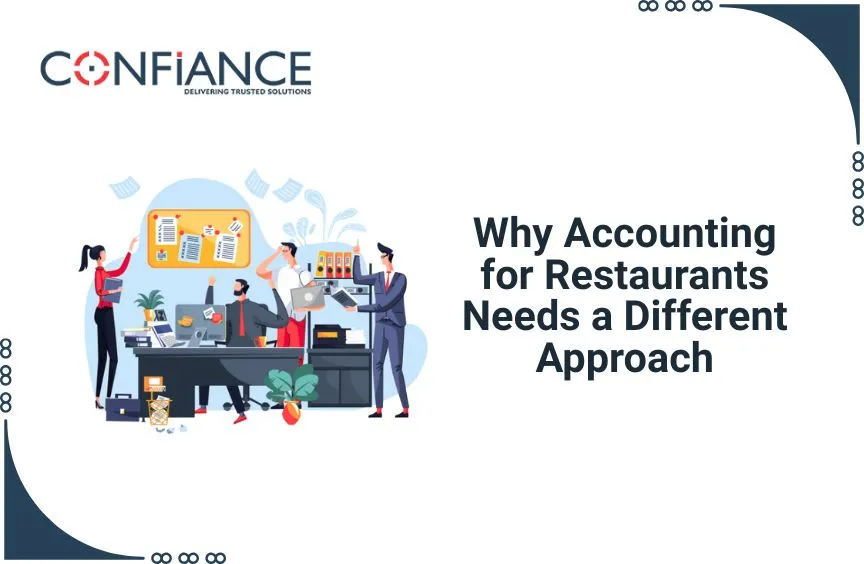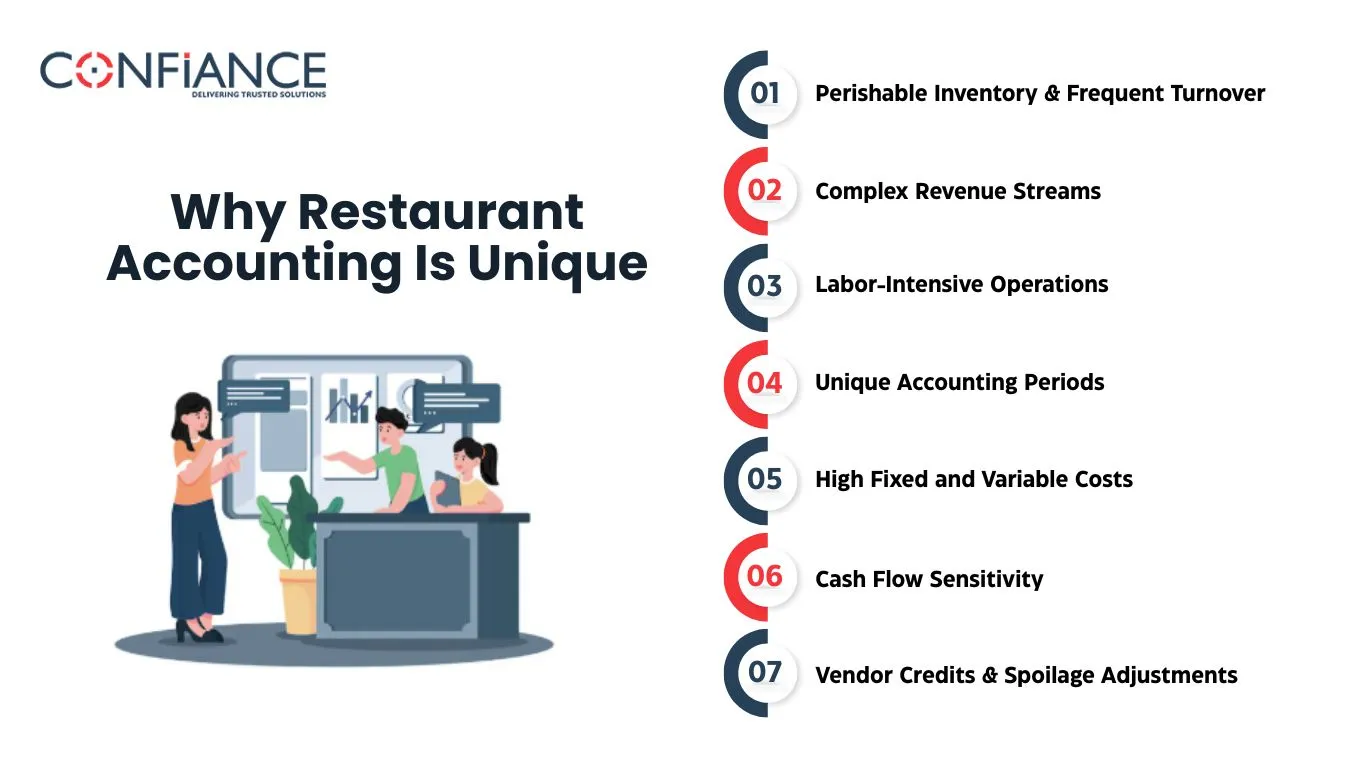
Why Accounting for Restaurants Needs a Different Approach
Running a restaurant is a busy job. You cook food, serve guests, manage workers, and try to make money. But keeping track of your money is different from other jobs. This is why accounting for restaurants needs its own plan. It is not like accounting for a store or a factory. Accounting in Restaurants also includes watching how much food gets used or thrown away, checking if the business is making a profit, and following tax rules.
Restaurants have special things like food waste, tips, daily sales, and fast costs. You need to track all of these carefully. This blog will help you understand why accounting in restaurants is unique and how to do it right.
What Is Accounting for Restaurants?
Accounting for restaurants involves tracking all the money a restaurant earns and spends. This means writing down how much money comes in from food sales, takeout, or delivery. It also includes tracking money that goes out, like paying for ingredients, workers, tips, rent, and bills. Restaurants have many small money changes every day, like buying vegetables, getting a food delivery, or paying kitchen staff. Because restaurants are fast-paced and have a lot of small parts, accounting for restaurants must be done carefully and often.
Why Restaurant Accounting Is Unique
1. Perishable Inventory & Frequent Turnover
Restaurants work with fresh food like fruits, vegetables, meat, and dairy. These items do not last long. They spoil fast and must be used in time. That’s why restaurants must track food daily or weekly.
Unlike stores that keep items for months, food can spoil in days. Wasting food also wastes money. This is why accounting for restaurants must include food checks often. It helps control the Cost of Goods Sold (COGS).
2. Complex Revenue Streams
Restaurants earn money from many places:
- Dine-in guests
- Takeout orders
- Online delivery
- Catering jobs
- Events or merchandise
Each of these brings in a different income. You must track each one separately. On top of that, workers earn tips, which must also be tracked. Tips are not wages but still need to be taxed and reported.
This makes accounting for restaurants more detailed than other jobs.
3. Labor-Intensive Operations
Restaurants hire many workers. Some are part-time. Some get tips. Some work long shifts. All of them must be paid fairly.
You must track:
- Hourly wages
- Overtime pay
- Tip pooling (shared tips)
- Shift changes
Labor is one of the biggest costs. Some restaurants consider the labor cost to be in the there total sales. If labor is too high, profit goes down.
4. Unique Accounting Periods
Most jobs use monthly accounting. But many restaurants use a 4-week or 4-4-5 system. This means each period has full weeks.
This helps restaurants:
- Compare weeks more easily
- Plan shifts and menus better
- Track sales in a fair way
It also keeps weekends in the same place every month, which is helpful for busy food spots.

5. High Fixed and Variable Costs
Restaurants have two types of costs:
Fixed costs (stay the same):
- Rent
- Electricity
- Insurance
Variable costs (change often):
- Food
- Worker pay
- Special ingredients
To plan their budget, restaurants often use a percent of sales instead of fixed numbers. If business is slow, spending must go down too.
6. Cash Flow Sensitivity
Restaurants usually work on small profits. That means every dollar counts. Cash comes in daily and goes out fast.
They must:
- Watch cash flow every week
- Create simple profit reports (P&L)
- Make changes fast if money is tight
Even if a restaurant is busy, poor cash flow can cause big problems.
7. Vendor Credits & Spoilage Adjustments
Sometimes, food is delivered late, spoiled, or wrong. Restaurants send it back and get a credit from the seller. This must be tracked.
Adjusting invoices is not common in other jobs, but in restaurants it happens often.
Specialized Metrics in Restaurant Accounting
1. Prime Cost
Prime cost is the total labor cost and food cost. Based on this you know how much you spend to make and serve food.
- It should be 60% or less of total sales.
2. Revenue per Seat Hour
This metric shows how much money each seat earns in one hour.
- It helps you know if your space is being used well.
3. Food Cost Percentage
This shows how much your ingredients cost compared to what you charge on the menu.
- Try to keep it at or below 30%.
4. Labor Cost Percentage
This shows how much you spend on staff compared to sales.
- Helps you manage your team size and hours.
5. Table Turnover Rate
This tells you how many groups use the same table in one shift.
- More turns usually mean more sales.
Using these numbers often helps restaurant owners make better plans and save money.
Best Practices for Restaurant Accounting
Following good habits helps make accounting for restaurants simple and clear. Here are some easy steps to follow:
1. Check Sales and Costs Every Week
Don’t wait for the end of the month. Look at your numbers every week to find problems fast and fix them.
2. Use Software That Fits Restaurants
Use tools made for restaurants like QuickBooks, Xero, or Restaurant365. These help track food, sales, and tips all in one place.
3. Count Your Inventory Often
Check your food stock at least once a week. This helps lower waste and makes your food cost numbers more exact.
4. Watch Labor Costs Daily
Track who works each day and how much they earn. Keep an eye on overtime and tips to stay in control.
5. Use a 4-4-5 Accounting Calendar
This system makes it easier to compare sales and plan better. It keeps each accounting period the same length.
6. Make Simple Reports You Understand
Make reports like weekly profit and loss (P&L) sheets and food cost charts. Use them to make smart choices.
7. Train Your Team on Tips and Pay Rules
Make sure all staff understand how tips work, what gets taxed, and how they get paid. This stops mistakes.
8. Work With Experts
Talk to a company like Confiance. We know accounting for restaurants and can help with tools, reports, and planning.
Accounting for restaurants is not simple. You deal with perishable food, tips, fast-changing costs, and daily sales. These things make restaurant money different from other types of businesses.
To stay successful, you must track inventory, watch labor, manage cash, and follow tax rules. That’s a lot to handle! Confiance knows what restaurant owners face each day. Our team can help set up systems, track key numbers, and keep your books clean. With Confiance by your side, you can stop worrying about the numbers and start focusing on serving great food.
Let Confiance help you with accounting, so your restaurant can stay strong, smart, and stress-free.
FAQs
1. Why is accounting for restaurants different?
Restaurants deal with food that can spoil, tips from guests, and fast money changes. These things make restaurant accounting more detailed and tricky.
2. What is the prime cost?
Prime cost is the total of food and labor costs. It helps show if the restaurant is making or losing money. It should be 60% or less of total sales.
3. What tools help with restaurant accounting?
Some good tools are QuickBooks for Restaurants, Restaurant365, and Xero with POS links. They help track sales, tips, and food costs.
4. How often should I check my numbers?
Many restaurants check sales, labor, and food costs every day or every week. This helps fix problems early.
5. Who can help with restaurant accounting?
A smart team like Confiance can help. We know how accounting for restaurants works
